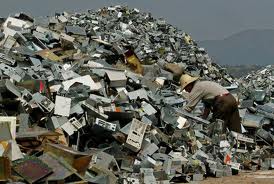Now that the holidays are over and so many gadgets have been replaced with the newest versions of TVs, cell phones and tablets, it’s inevitable that we’d write a story on how much e-waste the US makes.
This year is different however because, for the first time, emerging countries are throwing out even more electronics than we are in the US! Actually, the trend started in 2012.
Yes, countries like China, India, Brazil and South Africa have joined the party and are making up for lost time. E-waste is expected to surge 33% between 2012-2017, led by the developing world.
In just three years, the annual volume of e-waste will rise to 36.7 million tons in developing nations compared to “just” 28.6 million tons in the US, Europe, Japan and Australia combined. Stack it up and you’d reach heights of almost 200 Empire State Buildings.

Last year, an average of 15 pounds of electronics was produced for each of the world’s 7 billion people. That’s according to a report released by the United Nation’s Step Initiative (StEP), formed to tackle the enormous problem.
E-waste – the world’s fastest growing waste stream – includes anything with a plug, even old refrigerators and motorized toothbrushes.
Mapping the Magnitude of the Problem
StEP’s online E-Waste World Map graphically portrays the escalating problem by showing how much waste 184 countries generate each year.
“Although there is ample information about the negative environmental and health impacts of primitive e-waste recycling methods, the lack of comprehensive data has made it hard to grasp the full magnitude of the problem,” says Ruediger Kuehr, executive secretary of StEP.
China and the US lead the world on e-waste. Based on volume, China leads with 11.1 million tons, followed by the US at 10 million tons, but per capita, the US still holds the championship. There are 29.8 kilograms of waste for every American, six times higher than the Chinese (but they long to catch up).
The good news is that two-thirds of e-waste (56% by weight) is now collected for reuse or recycling and roughly 8.5% (3.1% by weight) is exported.
But because used electronics can be called “mixed metals” on import documents, they can be hard to track so there’s probably much more exported. Clearly, better tracking is needed, including codes specifically for used electronics, says StEP.
As you know, exports are a problem because they too often end up in toxic dumps, sifted through for valuable components by the world’s poor.
A million cellphones yields about 53 pounds of gold, 250 kilograms of silver, 9 killograms of palladium and 9 tons of copper, reports Reuters, all valuable materials.
Electronics Company Respond
Dell recently launched a large-scale e-waste recycling facility in East Africa, which many see as a model for waste collection and recycling in developing countries.
Jointly developed by Kenya’s government, NGOs, IT companies and e-waste recyclers, it creates a business model that ensures responsible recycling of e-waste while creating thousands of jobs.
Shipping containers will be set up at more than 40 collection points in Kenya, each functioning as an independent small business and purchasing e-waste from newly-trained individual collectors (from East Africa generally).
When a shipping container is full, business owers sell the contents to a central hub where the e-waste is processed into its components. Then, they are sold once again, this time back to the technology industry for reuse. Each stage is designed to be profitable for participants, from individual collector to collection point to hub.
No more will an army of informal “pickers” be exposed to hazardous, toxic waste and they pick through the debris – rather, they will be trained – by Dell and others – to safely collect and recycle the waste, and they will be compensated for their work.
Apple is also enticing customers to recycle their iPhones by offering a rebate of $345 when they turn in their “old” phone.

